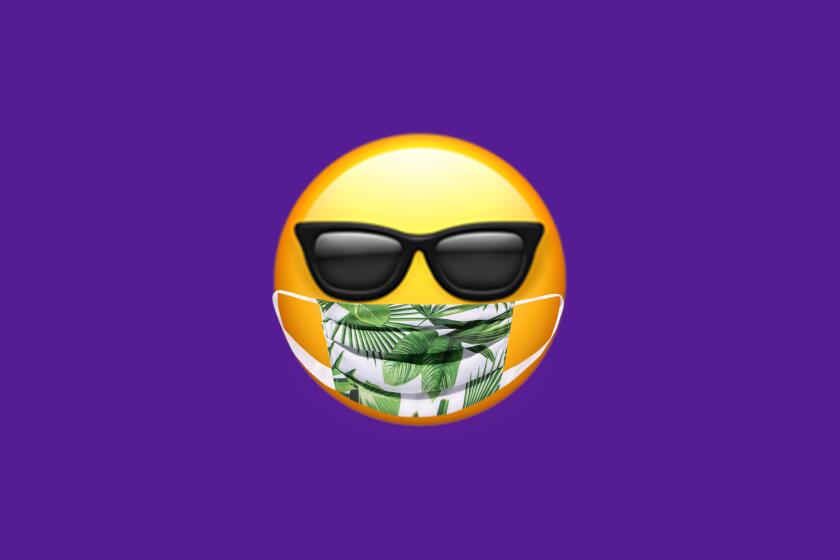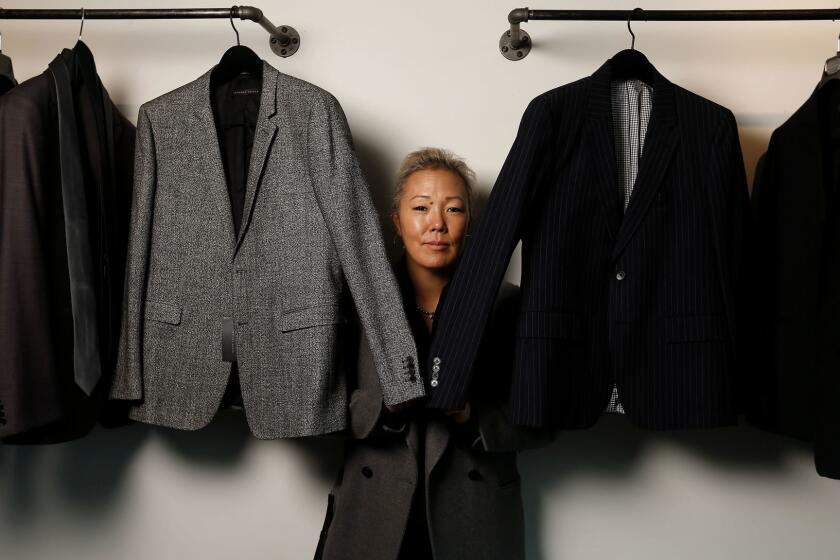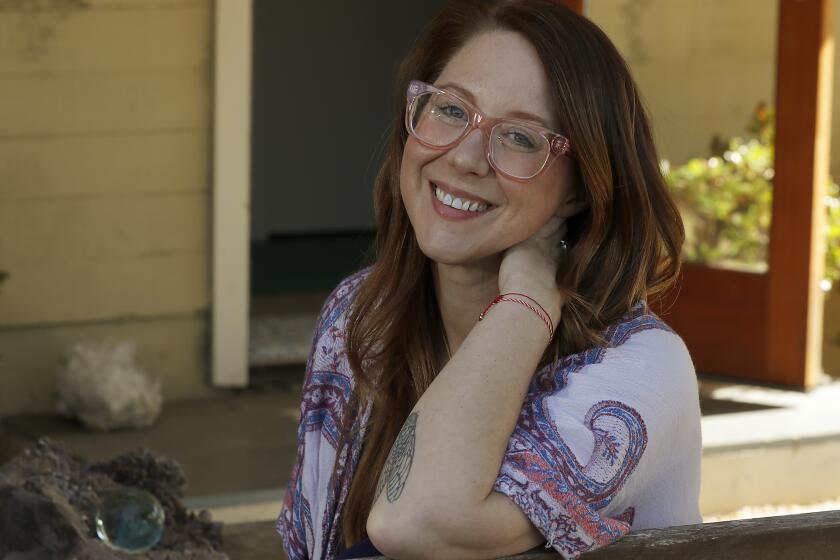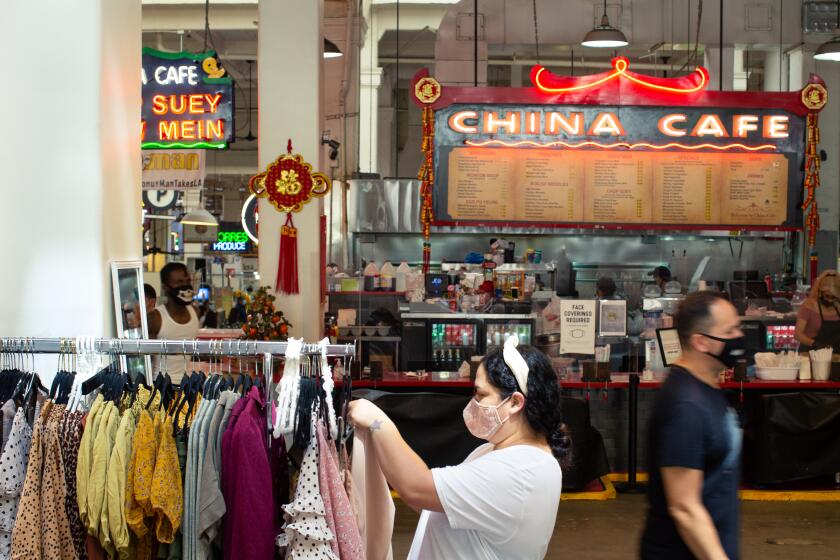The pandemic is changing the future of fashion and shopping. Why thatâs a good thing
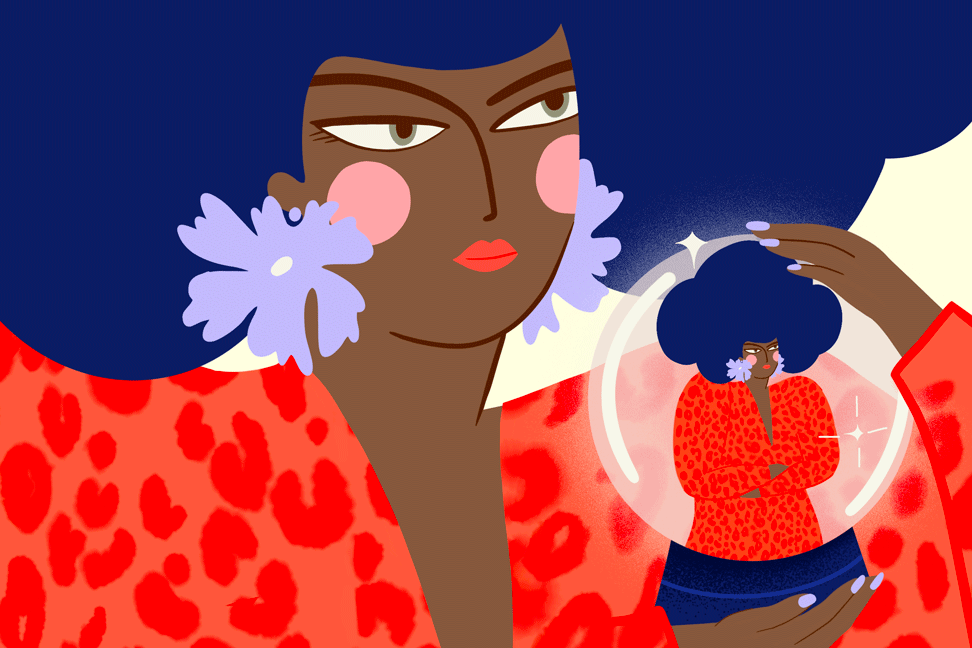
Given the chaos and uncertainty wrought by the COVID-19 pandemic, trying to pin down the top fashion and beauty trends of a year hence feels as futile as trying to pick a living room wallpaper pattern while your house is on fire. But we tried anyway by surveying a range of L.A.-based designers, brand builders and retailers to find out what the luxury landscape might look like 12 to 18 months down the road.
The general consensus? Although no one â not even the trend analysts who make their living forecasting such things â is exactly sure what the future of fashion looks like, what they agreed on is that, because of the pandemic, the future of retail and design is actually arriving way ahead of schedule, with back-burner projects front-burnered and fashionâs never-ending hamster wheel getting a good, hard look.
âWe had trends we were forecasting for 2021 that weâre seeing become a reality now,â said Ana Correa, an associate editor for footwear and accessories at trend-forecasting firm WGSN. âTheyâve accelerated because of the pandemic for sure.â
Correa was referring to two trends in particular: the home becoming a more important part of daily life and what she calls âdesigned-for-digitalâ things that resonate on a Zoom call or in an Instagram post such as statement earrings and iridescent colors. But the pandemicâs role as an accelerant can be seen and felt across the entire fashion and beauty landscape.
Weâre still in a pandemic. Cover up with some of our favorite face masks.
At Los Angeles-based handbag and accessories label Clare V., founder Clare Vivier said the future careened into view sooner than expected in two ways. When the coronavirus forced her to furlough employees and shutter her eight bricks-and-mortar retail stores in March, Vivier said she and her husband, Thierry, logged a lot of time in the brandâs L.A. warehouse, packing and shipping online orders.
âI realized we were shipping so much apparel â sweatshirts and T-shirts all day long â and I said, âWe need to get into more apparel immediately,ââ said Vivier, who built her 12-year-old brand on the popularity of cheery, colorful handbags, totes and accessories. âAnd thatâs what we did as soon as our apparel factory opened back up.â She called the acceleration of her labelâs fledgling apparel program âmonumental.â
Then when her retail stores reopened (including a new boutique at the Montecito Country Mart that opened Aug. 15), Vivier decided the time was right to pull the trigger on another idea sheâd been thinking about but had yet to implement: a tech feature on her website that allows customers to live-chat with an honest-to-goodness, actually-in-the-store employee, not a chat-bot or off-site third-party customer-service representative deep in the bowels of the internet.
âCOVID has made us speed up like five to 10 years,â Vivier said. âThis is something that weâd wanted to do, but it was fast-tracked real quick.â She added that the social-distancing aspect of the pandemic has, more generally, accelerated the wider embrace of e-commerce. âPeople who were a little bit shy to shop online before are definitely not shy anymore.â
E-commerce wasnât an option for full-service L.A. manicure bar Color Camp, said founder and Chief Executive Lauren Polino, who was forced to close her two SoCal salons (one in the Fairfax District and one in Studio City) when Los Angeles Countyâs stay-at-home measures went into effect in mid-March. Yet just five weeks later, Color Camp rolled out at-home super gel manicure kits complete with hand-painted designs on reusable press-on nails selling in the $56-to-$72 range.
Pop-up drive-ins, pet pigs and quality time with college-bound kids help fill the void.
âI was thinking we [couldnât] do our regular services so letâs come up with something for people to do at home,â said Polino, noting that the idea of augmenting her salon services with some kind of product line had been on her radar for a while. âBut it probably would have taken me at least six to 12 months to do the regular product development,â she said.
Like many other hair and nail salons around the city, Color Camp tried to adapt by offering its services outdoors. Although a three-day pop-up at Platform in Culver City proved wildly popular â selling out 60 spots in two hours and generating a wait list just as long â Polino said that because of dust, sunlight and other logistical challenges, sheâs not keen on offering manicures al fresco.
As a result of its pandemic-precipitated pivot, Color Camp has been able to keep 10 nail artists employed (they hand-paint the nail art at home) and stay afloat (Polino said the revenue from the kits is about what one of her two salons would have generated during the same period). And with two-thirds of the DIY gel nail kits shipping out of state (theyâre popular in Florida, Texas and Washington, D.C., according to Polino), the new offering had the added benefit of expanding brand awareness beyond SoCal in a way that otherwise wouldnât have been possible.
Polino said the kits will still be on offer after Color Campâs bricks-and-mortar salons reopen for business. âThis is giving us an opportunity to reach our audience far beyond what we would have just having our salons,â she said, âso weâre going to keep doing it.â
Home color kits and Zoom crystal readings fill the void. But underground services break the lockdown.
The rising popularity of DIY options in the beauty space makes sense given the difficulty of staying physically distant. (According to Clare Hennigan, a senior beauty analyst at market-research firm Mintel, 50% of Americans are currently not comfortable getting in-salon beauty treatments.)
Luxury fashion has been having its own DIY moment too. Examples include a color-blocked JW Anderson cardigan that became the focus of a viral crocheting challenge on the mobile video platform TikTok and former Givenchy artistic director Clare Waight Keller showing readers of the New York Times how to make a blanket cape in that newspaperâs Designer D.I.Y. series.
In April, when L.A.-based designer Reese Cooper, a 2020 nominee for the Council of Fashion Designers of Americaâs emerging designer of the year award, offered a $98 DIY kit that included all the materials and instructions to make an at-home version of his signature workwear-inspired coat right down to the patches and snap buttons, the run of 1,000 kits sold out immediately. (The jacket kits are back in stock now, along with shirt-dyeing kits and affix-your-own embroidered patches, via his labelâs dedicated DIY page.)
Cooper said creating the kits wasnât part of any long-term strategy but rather a way to continue â from afar â the bonding with fans and customers over DIY projects that used to take place during the arts-and-crafts-focused open houses at his Glassell Park studio. âIt was really fun,â Cooper said of the initial response to his DIY-in-a-box offering. âPeople posted pictures [on Instagram] so I got to see a bunch of people â some who had never sewn before â do their thing. It was fun and it did well for me business-wise.â
The designer, whose 4-year-old label is still in growth mode, said the future that arrived ahead of schedule for him came in the form of several small, behind-the-scenes upgrades to infrastructure: things like hiring his first full-time employee (to help grow the direct-to-consumer side of the business) and relocating to a new office in downtown Los Angeles that includes a showroom suitable for private-appointment shopping. âAll that stuff is on the front burner right now because Iâm home and can actually be involved,â Cooper said, adding that last year he was averaging one plane flight every 10 days. âI think I slept in my own bed maybe nine or 10 nights a month.â
When their foot traffic dropped, some Los Angeles pop-up fashion vendors learned to adapt by offering at-home digital experiences, Instagram Live sessions and online resources.
One of the flights Cooper didnât take this summer was to Paris, where he was set to present his spring and summer 2021 collection as part of the official Paris menâs fashion week calendar for the first time. He ended up presenting his collection virtually â through YouTubeâs livestreaming platform â where it has been viewed more than 176,000 times in just six weeks.
âThatâs [compared to my] show in January, where there were only 250 people in the room,â Cooper said. âI like the idea that everyone got to see the collection at the same time. There was no gatekeeper. There was no preferential treatment. Everyone was equal.â
L.A.-based menswear designer John Elliott also had planned to present a new collection in Paris in July â a collection that, for now, remains unlaunched. (Elliott said the spring and summer 2021 collection, titled âWhere the Concrete Meets the Earth,â explores the duality of city and outdoor life.)
âIn a weird way, Iâm actually fine with that,â Elliott said. âI think the way the [fashion] calendar was, it was just so fast and so vicious. ⌠Now Iâm trying to rethink the calendar so it works better for the brand. We do four collections a year, so having the opportunity to slow down and reassess and sharpen the sword a little bit is really refreshing.â
The future of the fashion-week format has yet to come into focus. The first inkling might come when a much-shortened four-day New York Fashion Week, featuring a mix of in-person appointments and digital activations (think virtual runway shows), kicks off Sept. 13.
Elliott thinks the slowing of the hamster wheel caused by efforts to flatten the coronavirus curve could lead to long-needed, long-term, fundamental changes to the fashion-industrial complex.
Meet Christian Guernelli, the Culver City fashion designer, behind an all-digital model squad.
âI donât know how many designers would want to admit it,â Elliott said, âbut once youâre on the treadmill of doing shows and launching collections, thereâs a fear that everyone has that if you jump off the treadmill, people are going to worry and say, âOh man, that brand is in trouble.â Now, because of this, everybody has the ability to do whatâs best for them, and thatâs a beautiful thing. I think itâs going to make product better. I think itâs going to [result in] more creative ways to showcase product, to launch collections and to highlight ideas. ⌠[And] itâs going to allow for product to be a little bit more purposeful.â
Elliott isnât alone in thinking the dark cloud of COVID-19 might have a silver lining for the future of fashion. âMaking the Cutâ reality show winner Jonny Cota, who channeled some of his $1 million in winnings into a futuristic and pandemic-proof revamp of his store at the Row DTLA (think virtual store tours, cashless and touchless checkouts and many a scannable QR code), is similarly upbeat about what the fashion world might look like in the future.
âAt the risk of sounding like a total optimist, I think the year ahead really has limitless possibilities,â Cota said. âThe only constant in this world is change, and there hasnât been much change in the fashion industry in the last 15 years. [Now] everythingâs shifting. Major retailers are fading away. Fashion week is shifting. Iâm really excited about how fashion designers can reimagine the fashion world. I think itâs going to be smaller collections, a language thatâs geared more directly to our customers, and kind of redefining how we present the fantasy that is fashion.â
If Elliott and Cota are right in their hopes that the pandemic might in some weird way turn out to be just what the hidebound fashion world needs, then no matter how fast it accelerates the future canât get here soon enough.
Get The Wild newsletter.
The essential weekly guide to enjoying the outdoors in Southern California. Insider tips on the best of our beaches, trails, parks, deserts, forests and mountains.
You may occasionally receive promotional content from the Los Angeles Times.
More to Read
Sign up for The Wild
Weâll help you find the best places to hike, bike and run, as well as the perfect silent spots for meditation and yoga.
You may occasionally receive promotional content from the Los Angeles Times.

